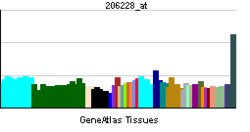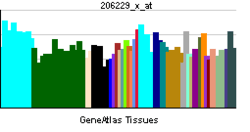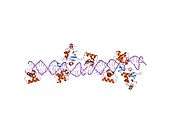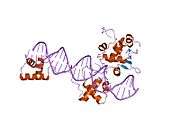PAX2
| View/Edit Human | View/Edit Mouse |
Paired box gene 2, also known as PAX2 is a protein which in humans is encoded by the PAX2 gene.[3][4]
Function
The Pax Genes, or Paired-Box Containing Genes, play important roles in the development and proliferation of multiple cell lines, development of organs, and development and organization of the central nervous system.[5] The transcription factor gene Pax2 is important in the regionalized embryological development of the central nervous system. In mammals, the brain is developed in three regions: the forebrain, midbrain, and the hindbrain.[6] Concentration gradients of fibroblast growth factor 8 (FGF8) and Wingless-Type MMTV Integration Site Family, Member 1 (Wnt1) control expression of Pax2 during development of the Mesencephalon, or midbrain.[7] Similar patterning during embryological development can be observed in “basal chordates or ascidians,” in which organization of the central nervous system in ascidian larvae are also controlled by fibroblast growth factor genes.[6] The Pax2 gene encodes for the transcription factor which appears to be essential in the organization of the midbrain and hindbrain regions, and at the earliest can be detected on either side of the sulcus limitans, which separates motor and sensory nerve nuclei.[5][8]
PAX2 encodes paired box gene 2, one of many human homologues of the Drosophila melanogaster gene prd. The central feature of this transcription factor gene family is the conserved DNA-binding paired box domain. PAX2 is believed to be a target of transcriptional suppression by the tumor suppressor gene WT1. Pax 2 is a transcription factor controlled by the signaling molecules Wnt1 and Fgf8. Pax2 along with other transcription factors Pax5, Pax8, En1, and En 2 are expressed across the Otx2-Gbx2 boundary in the mid-hindbrain region. These transcription factors work with the signaling molecules Wnt1 and Fgf8 to maintain the MHB organizer. The MHB controls midbrain and cerebellum development. Pax2 is the earliest known gene to be expressed across the Otx2-Gbx2 boundary. It is first expressed in the late primitive streak stage and is expressed in a narrow ring centered at the MHB during somitogenesis. Transgene expression of the mid-hindbrain and developing kidney is directed by Pax2. There are three distinct MHB-specific enhancers in the upstream region of Pax2. Expression at the MHB from the four-somite stage onwards is directed by the two late enhancers in the proximal and distal regions of Pax2. The early enhancer located in the intermediate region activates the mid-hindbrain region of late gastrula embryos. The activation of Pax2, Pax5, and Pax8 is a conserved feature of all vertebrates.
Clinical significance
Pathologically, Pax2 has been demonstrated to activate hepatocyte growth factor (HGF) gene promoter, and both have been indicated as playing a role in human prostate cancers.[9]
Mutations within PAX2 have been shown to result in optic nerve colobomas and renal hypoplasia. Alternative splicing of this gene results in multiple transcript variants.[10] Pax2 and Pax8 are also necessary for the formation of the pronephros and subsequent kidney structures. Pax2 and Pax8 regulate the expression of Gata3. Without these genes mutations in the urogenital system arise.
Interactions
PAX2 has been shown to interact with PAXIP1.[11]
See also
References
- ↑ "Human PubMed Reference:".
- ↑ "Mouse PubMed Reference:".
- ↑ Pilz AJ, Povey S, Gruss P, Abbott CM (1993). "Mapping of the human homologs of the murine paired-box-containing genes". Mammalian Genome. 4 (2): 78–82. doi:10.1007/BF00290430. PMID 8431641.
- ↑ Stapleton P, Weith A, Urbánek P, Kozmik Z, Busslinger M (Apr 1993). "Chromosomal localization of seven PAX genes and cloning of a novel family member, PAX-9". Nature Genetics. 3 (4): 292–8. doi:10.1038/ng0493-292. PMID 7981748.
- 1 2 Mansouri A, Gruss P (2013). "Pax Gene". In Hughes K, Maloy K. Brenner’s Encyclopedia of Genetics (2nd ed.). San Diego: Elsevier Science. pp. 246–248. doi:10.1016/B978-0-12-374984-0.01128-1. ISBN 978-0-08-096156-9.
- 1 2 Imai KS, Satoh N, Satou Y (2002). "Region specific gene expressions in the central nervous system of the ascidian embryo". Mechanisms of Development. 119 Suppl 1: S275–7. doi:10.1016/S0925-4773(03)00128-X. PMID 14516697.
- ↑ GeneCard for WNT1
- ↑ Nolte J (2009). The human brain: an introduction to its functional anatomy (6th ed.). Philadelphia, PA: Mosby/Elsevier. p. 685. ISBN 978-0-323-04131-7.
- ↑ Ueda T, Ito S, Shiraishi T, Taniguchi H, Kayukawa N, Nakanishi H, et al. (2015). "PAX2 promoted prostate cancer cell invasion through transcriptional regulation of HGF in an in vitro model". Biochimica et Biophysica Acta. 1852 (11): 2467–73. doi:10.1016/j.bbadis.2015.08.008. PMID 26296757.
- ↑ "Entrez Gene: PAX2 paired box gene 2".
- ↑ Lechner MS, Levitan I, Dressler GR (Jul 2000). "PTIP, a novel BRCT domain-containing protein interacts with Pax2 and is associated with active chromatin". Nucleic Acids Research. 28 (14): 2741–51. doi:10.1093/nar/28.14.2741. PMC 102659
 . PMID 10908331.
. PMID 10908331.
Further reading
- Noll M (Aug 1993). "Evolution and role of Pax genes". Current Opinion in Genetics & Development. 3 (4): 595–605. doi:10.1016/0959-437X(93)90095-7. PMID 8241771.
- Dahl E, Koseki H, Balling R (Sep 1997). "Pax genes and organogenesis". BioEssays. 19 (9): 755–65. doi:10.1002/bies.950190905. PMID 9297966.
- Eccles MR, He S, Legge M, Kumar R, Fox J, Zhou C, French M, Tsai RW (2003). "PAX genes in development and disease: the role of PAX2 in urogenital tract development". The International Journal of Developmental Biology. 46 (4): 535–44. PMID 12141441.
- Eccles MR, Wallis LJ, Fidler AE, Spurr NK, Goodfellow PJ, Reeve AE (May 1992). "Expression of the PAX2 gene in human fetal kidney and Wilms' tumor". Cell Growth & Differentiation. 3 (5): 279–89. PMID 1378753.
- Sanyanusin P, Schimmenti LA, McNoe LA, Ward TA, Pierpont ME, Sullivan MJ, Dobyns WB, Eccles MR (Apr 1995). "Mutation of the PAX2 gene in a family with optic nerve colobomas, renal anomalies and vesicoureteral reflux". Nature Genetics. 9 (4): 358–64. doi:10.1038/ng0495-358. PMID 7795640.
- Ward TA, Nebel A, Reeve AE, Eccles MR (Sep 1994). "Alternative messenger RNA forms and open reading frames within an additional conserved region of the human PAX-2 gene". Cell Growth & Differentiation. 5 (9): 1015–21. PMID 7819127.
- Stapleton P, Weith A, Urbánek P, Kozmik Z, Busslinger M (Apr 1993). "Chromosomal localization of seven PAX genes and cloning of a novel family member, PAX-9". Nature Genetics. 3 (4): 292–8. doi:10.1038/ng0493-292. PMID 7981748.
- Pilz AJ, Povey S, Gruss P, Abbott CM (1993). "Mapping of the human homologs of the murine paired-box-containing genes". Mammalian Genome. 4 (2): 78–82. doi:10.1007/BF00290430. PMID 8431641.
- Sanyanusin P, McNoe LA, Sullivan MJ, Weaver RG, Eccles MR (Nov 1995). "Mutation of PAX2 in two siblings with renal-coloboma syndrome". Human Molecular Genetics. 4 (11): 2183–4. doi:10.1093/hmg/4.11.2183. PMID 8589702.
- Sanyanusin P, Norrish JH, Ward TA, Nebel A, McNoe LA, Eccles MR (Jul 1996). "Genomic structure of the human PAX2 gene". Genomics. 35 (1): 258–61. doi:10.1006/geno.1996.0350. PMID 8661132.
- Dehbi M, Ghahremani M, Lechner M, Dressler G, Pelletier J (Aug 1996). "The paired-box transcription factor, PAX2, positively modulates expression of the Wilms' tumor suppressor gene (WT1)". Oncogene. 13 (3): 447–53. PMID 8760285.
- Bonaldo MF, Lennon G, Soares MB (Sep 1996). "Normalization and subtraction: two approaches to facilitate gene discovery". Genome Research. 6 (9): 791–806. doi:10.1101/gr.6.9.791. PMID 8889548.
- Schimmenti LA, Cunliffe HE, McNoe LA, Ward TA, French MC, Shim HH, Zhang YH, Proesmans W, Leys A, Byerly KA, Braddock SR, Masuno M, Imaizumi K, Devriendt K, Eccles MR (Apr 1997). "Further delineation of renal-coloboma syndrome in patients with extreme variability of phenotype and identical PAX2 mutations". American Journal of Human Genetics. 60 (4): 869–78. PMC 1712484
 . PMID 9106533.
. PMID 9106533. - Narahara K, Baker E, Ito S, Yokoyama Y, Yu S, Hewitt D, Sutherland GR, Eccles MR, Richards RI (Mar 1997). "Localisation of a 10q breakpoint within the PAX2 gene in a patient with a de novo t(10;13) translocation and optic nerve coloboma-renal disease". Journal of Medical Genetics. 34 (3): 213–6. doi:10.1136/jmg.34.3.213. PMC 1050895
 . PMID 9132492.
. PMID 9132492. - Tavassoli K, Rüger W, Horst J (Dec 1997). "Alternative splicing in PAX2 generates a new reading frame and an extended conserved coding region at the carboxy terminus". Human Genetics. 101 (3): 371–5. doi:10.1007/s004390050644. PMID 9439670.
- Stayner CK, Cunliffe HE, Ward TA, Eccles MR (Sep 1998). "Cloning and characterization of the human PAX2 promoter". The Journal of Biological Chemistry. 273 (39): 25472–9. doi:10.1074/jbc.273.39.25472. PMID 9738017.
- Devriendt K, Matthijs G, Van Damme B, Van Caesbroeck D, Eccles M, Vanrenterghem Y, Fryns JP, Leys A (Aug 1998). "Missense mutation and hexanucleotide duplication in the PAX2 gene in two unrelated families with renal-coloboma syndrome (MIM 120330)". Human Genetics. 103 (2): 149–53. doi:10.1007/s004390050798. PMID 9760197.
- Schimmenti LA, Shim HH, Wirtschafter JD, Panzarino VA, Kashtan CE, Kirkpatrick SJ, Wargowski DS, France TD, Michel E, Dobyns WB (2000). "Homonucleotide expansion and contraction mutations of PAX2 and inclusion of Chiari 1 malformation as part of renal-coloboma syndrome". Human Mutation. 14 (5): 369–76. doi:10.1002/(SICI)1098-1004(199911)14:5<369::AID-HUMU2>3.0.CO;2-E. PMID 10533062.
External links
- GeneReviews/NCBI/NIH/UW entry on Renal Coloboma Syndrome
- PAX2 protein, human at the US National Library of Medicine Medical Subject Headings (MeSH)
This article incorporates text from the United States National Library of Medicine, which is in the public domain.




